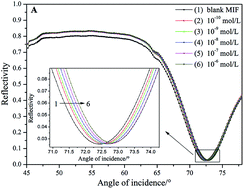Surface plasmon resonance sensor for theophylline using a water-compatible molecularly imprinted film
Abstract
A water-compatible molecularly imprinted film (MIF) was anchored onto a gold-coated glass surface for the fabrication of a surface plasmon resonance (SPR) sensor that was sensitive to theophylline. The self-assembly of the functional monomer, methacrylic acid, around the template, theophylline, in distilled water was studied by UV-vis spectrophotometric analysis. Based on this study, the MIF on a SPR chip was fabricated through visible light-initiated copolymerization of methacrylic acid (the functional monomer) and N,N′-methylenebisacrylamide (the crosslinker) in the presence of theophylline as a model template in the aqueous phase, using the combination of methylene blue (a red-sensitive dye) and sodium p-toluenesulfinate (a reducing agent) as the photo-redox initiator. The template molecules were then removed to form a MIF with specific recognition sites for theophylline. The unmodified and imprinted surfaces were characterized by contact angle measurements, atomic force microscopy (AFM), and scanning electron microscopy (SEM). The imprinted SPR sensor was found to be sensitive, selective, and linear. The linear range of detection for the theophylline concentration was 10−10 to 10−6 mol L−1 and the detection limit of the prepared sensor was calculated as 1.0 × 10−10 mol L−1 in phosphate buffered saline (PBS). Furthermore, the repeatability of the prepared MIF sensor was studied. The sensors displayed acceptable reproducibility of fabrication, making them attractive in sensor studies. Finally, the developed theophylline-imprinted SPR sensor was successfully applied to determine the theophylline concentration in wastewater samples.


 Please wait while we load your content...
Please wait while we load your content...